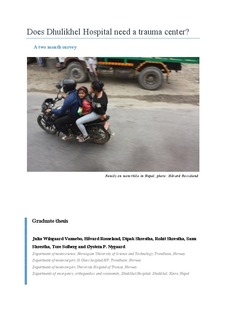| dc.description.abstract | Background: Most epidemiologic research in low-income countries tends to focus on
diseases, however, one of the leading causes of death is traumatic injuries, especially
traumatic brain injury (TBI) and spinal injury. Few studies on trauma and neurotrauma have
been conducted in Nepal.
Objective: To investigate the epidemiology of all physical traumas at Dhulikhel Hospital
(DH), with special attention to TBI and spinal injury.
Materials and methods: This is a cross sectional descriptive study which included all trauma
patients registered at the Emergency department (ED) at DH between February 1st 2016 and
April 4th 2016, and is an extension of a survey from 2011. Information about demographics,
mechanism of injury, time of injury, location of injury, Glasgow Coma Scale (GCS), Loss of
Consciousness, treatment and transfer of patients was recorded. CT images of head and spine
and spinal x-rays were assessed for classification.
Results: 726 patients were included in the study. Mean age was 31.7 years and 54.1 % ≤ 30
years old. The male to female ratio was 1.83. 32.6 % contacted the ED with a history of head
trauma; 19.8 % had moderate head injuries and 8.4 % had severe head injuries according to
the Head injury severity scale (HISS). 18 % of the head traumas were referred for
neurosurgical evaluation and management outside DH. In 80 cases CT imaging of the head
was evaluated, out of which 11.3 % showed intracranial pathology.
Conclusion: From 2011 to 2016 there has been an 80% increase of trauma patients at DH.
The proportion of head injuries is large, and moderate or severe head injuries are frequent.
Many of the head injuries are referred for neurosurgical evaluation and management outside
DH. Our data show high frequency of trauma, especially head injuries, indicating that it
would be reasonable to establish a neurosurgical unit at a trauma center at DH. | nb_NO |
